Intention—Distinguishing Champions from the Ordinary
By Dr. Christopher R Holder DP, DMQ(China), Senior RKC
Chris Holder's training partner, Chris White, swings two 32kg kettlebells
When I wrote this, I wanted to step away from the norm. I could write article after article about swings and get-ups, but wanted this piece to be about something I hold near and dear. I pride myself on being somewhat of a nerd—I read EVERYTHING. Typically, if you want to read about kettlebells, you need a kettlebell
book, or a kettlebell website. The same is true for barbell training, coaching, or the mental game. But, none of us live in isolation. The marrying of ideas is essential because compartmentalizing them leads to further confusion when someone attempts to integrate these concepts in training.
In the college strength and conditioning world, I have to be the strength coach, speed coach, flexibility guru, dietician, counselor, and from time to time the bad guy. It’s taken me almost 15 years to get comfortable mixing ideas, approaches, and ideologies. On paper, my experiences and areas of expertise could be considered unrelated, but after looking farther down the rabbit hole, I’ve found
everything is related to
everything.
All of us know what the word
intention means. But, it’s a word we all use from time to time without much thought. Merriam-Webster defines intention as, "What you plan to do or achieve, an aim or purpose." Have you really thought about the idea or meaning of intention? Or more importantly, have you used the power of intention to fuel the direction of your training sessions?
For those of you who don’t know much about me, I’m a Senior RKC and a Chinese Medical Qigong Doctor. I’ve been in practice for a little over two years, and although most of us are oblivious to its potential have really seen the world of energy and magic where we all live. Our beloved Dragon Door CEO understands it, as do high level martial artists (especially my kung-fu brothers and sisters).
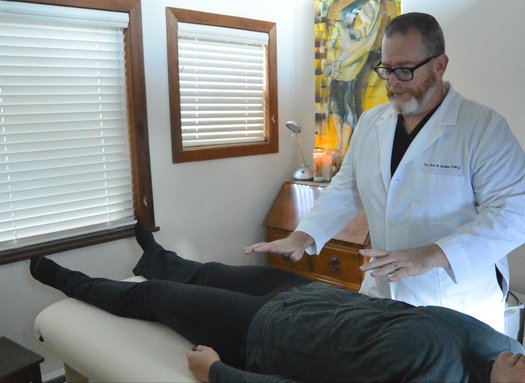
Unfortunately, most of us go through our day oblivious to the sea of energy flowing around, through, and within us—which we can direct. I’m not trying to sound strange, but I also wanted to let you know about the thousands of patients with a variety of "incurable" ailments who were miraculously healed by qigong. Qi means energy, and gong means skill. I’m able to direct the energy during a qigong treatment because of one simple mechanism—intention.
This isn’t just an article about qigong, it’s a
kettlebell and weight training article seasoned with qigong. We’ve all seen self-help gurus, healers, and shamans who make extraordinary claims of healing, impossible feats, and miracles. But, once you immerse yourself in the world of energetics, you’ll soon realize we have the power within ourselves to manipulate every aspect of our lives with appropriate, focused intention.
Most of us begin a training session with a fairly focused plan—we know what exercises we want to do, and which weights to use. Some of us even keep a fairly detailed log. This is awesome, but it’s only a third of what we could be doing. Intention takes the level of planning and level of presence to a new level. The most dangerous person in a training space is someone aimlessly performing tasks with no understanding of how or why.
The RKC is a brilliant system because we leave no stone unturned. After an
RKC certification weekend, participants have a depth of understanding of the RKC 6 that they can immediately use to change lives. This tool set can make you one of the most effective kettlebell trainers in the world, and it also contains concepts applicable to barbells, dumbbells, and conditioning.
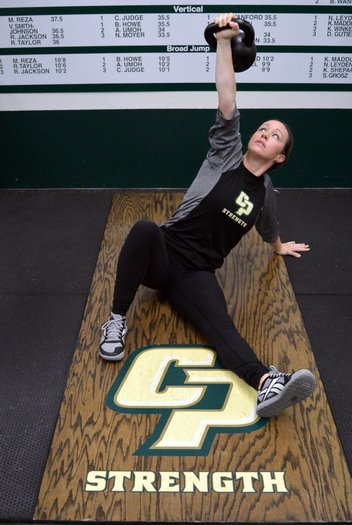
Let’s break down the concept of intention:
NUANCES
The RKC is full of small intricate ideas, concepts, and adjustments that can change the nature of a given exercise. For example, have you ever SERIOUSLY cramped your glutes? One of the drills we use to introduce the kettlebell swing at Cal Poly is a very simple drill—as a group, my athletes will stand and squeeze their glutes as hard as possible. Then, they hold that contraction for a full minute while I cue them to squeeze harder and harder causing them to find new levels of tension. Before this drill, most of my athletes had never experienced truly cramped glutes.
Another nuance is the idea of bending the kettlebell handle during swings. This automatically packs the shoulders and shoulder blades, effectively sealing up any energy leaks, and giving the athlete more power to direct the energy generated from the hips. Another nuance is the practice of grunting before standing up out of the hole in a goblet or front squat. This grunt instantly creates intra-abdominal pressure, increases power, and also protects the spine. A rich understanding of minute details like these examples can vastly increase intention.
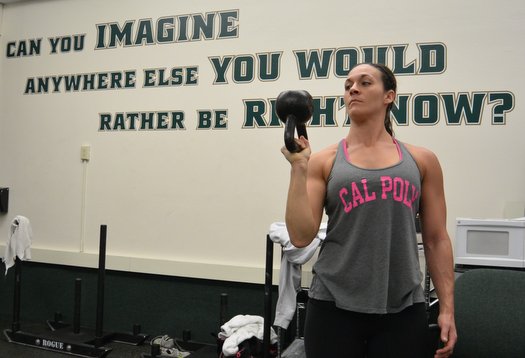
FOCUS
One of the biggest issues I have with my athletes is the lack of focus they sometimes have during training—wandering eyes, rushing through exercises, cutting the rep ranges, you name it. The dark side of Coach Holder comes out when athletes are unfocused in the weight room. Most people don’t truly understand that the human body is like a machine with billions—on the cellular level—of moving parts. The complex movement of the kettlebell press, if broken down to its smallest elements is a magnificent act of full body synergy—even if it’s a somewhat ordinary task. It’s remarkable to think about. Complex movements like the press require a pin-point focus to dramatically increasing the efficacy of the movement while reducing the chance of injury.
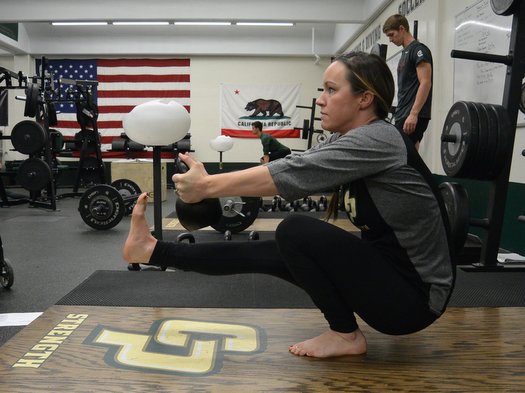
BEING PRESENT
At first, there doesn’t seem to be a big difference between being focused and being present. But, how many of you are completely present for every rep of every set during your training sessions? By present, I mean taking inventory of what you’re feeling, making small adjustments, and modulating effort through each set and rep. If we immediately think we’ve been fully present during our training sessions, most of us are not being honest with ourselves. My wife says in the volleyball world, being present is also known as "mindfulness".
Texting, talking to people in your space, staring at a girl on the treadmill, or jamming out to the song playing on your headphones are all ways of not being present. (Although, you haven’t lived if you haven’t tried heavy grinds or high volume swings to A Perfect Circle’s "Counting Bodies Like Sheep".) During a session, are you aware of your surroundings? Are you conscious of where your feet are prior to starting your set of swings? Do you monitor your breathing throughout the set to make sure it matches your effort? Are you truly present?
Your intention sets the tone of the entire training session—each set and rep. I just completed a month of 10,000 swings—you’ve probably seen the program on Facebook. Performing the world’s greatest exercise 10,000 times sounded like a dream come true, but it was more like a nightmare! At 3,000 swings, I asked myself, "WHY THE HELL AM I DOING THIS?!" But, I was committed by that time and buckled down for the dog days ahead.
My training partners and I originally planned to do 500 swings a day, Monday through Friday, and rest on the weekends. But Chris White, one of our training partners was leaving town on the Thursday of the final week to attend the Arnold in Ohio. And we planned to have a celebratory dinner at our favorite pizza joint, before getting foot massages as a reward for finishing 10,000 swings.
To complete 10,000 swings a day earlier, we decided to do 50-100 extra swings on the weekends. On the last week, I had to squeeze in 250 more swings in addition to the daily 500 to make 10,000 by Thursday. On that Tuesday, I decided to man-up and do 750 swings in 75 sets of 10. Between each set I took a short 30-second stroll around my weight room to shake off the tension and keep me on pace. By set 74, I was completely dialed-in. I swing hard—cramping my glutes, making my abs tight, and pulling up my knee-caps to make my quads rock hard on every rep. At the top of rep 736, I blacked out—I fainted. I woke up with the bell between my legs, and my knees basically touching. The instant I came to, I sprang back into action and finished the remaining reps. At the time, I didn’t know where I was other than I was fairly certain I was swinging a kettlebell, then a wave of fear came over me.
Besides poking a little fun at myself, I shared this story as an example of the power of intention. Because I have logged so many reps with crystal clear intention, I was able to recover (fairly gracefully) because I established the intention of every set of swings from the beginning. However, I will admit that the 75th set was performed very carefully. With 9,985 reps for the month performed in a balls-to-the-wall style, I did the last 15 with the intention of survival!
Tai Chi masters, high level yogis, shamans, and Medical Qigong Doctors move energy by intention. We understand the nuances of the energy. We have laser-like focus and are fully present in the task at hand. The energy moves because we will it to move—our intention directs the Qi. I liken my time in medical school to spending time in Jedi training. I was lucky enough to learn from and train with one of the greatest Qigong Grandmasters alive, Dr. Jerry Alan Johnson. I spent years cultivating and working the Qi with him until we were basically able to move it by just thinking about it—intention. We refined this task to the point where we could—and can—do things most people would think are impossible.
This same intention can drive your training sessions. Consider what you’re trying to accomplish with your lift today. For example, you might swing a
32kg kettlebell with focus and power because you want to jump higher. You may want to focus in great detail on get-ups to improve your shoulder stability. Or you might want to be extra sharp with your form on a set of 20 snatches to help master the technique. You bring about what you think about, so it’s important to consider what you’re thinking about during your training.
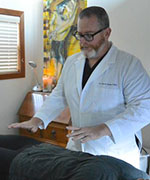 Chris Holder can be contacted by email at holder54@hotmail.com (mention RKC in the email subject so your email isn't accidentally deleted).
Chris Holder can be contacted by email at holder54@hotmail.com (mention RKC in the email subject so your email isn't accidentally deleted).
Back